Overview
In this lesson, students will learn how journalists and artists responded to the practice of lynching and racial injustice in the U.S., including learning about the journalism of Ida B. Wells and artistic expression such as Billie Holiday’s “Strange Fruit.” Students will then create their own artistic project — either poetry or a “quilt” collage of related images that depict contemporary incidents of racial injustice.Objectives
- Students will analyze the history and “viral spread” to lynching and how it has been depicted in media in the U.S. since 1865.
- Students will determine the central ideas or information of a primary or secondary sources on lynching and racial injustice.
- Students will choose to express thoughts about the history of lynching through a medium of artistic expression such as poetry or collage.
Subjects
English language arts, fine arts, U.S. history, U.S. government & civics, criminal justice, legal studies.Grade Levels
Grades 6 – 12Standards
-
Common CoreCCSS.ELA-LITERACY.RH.6-8.4 Determine the meaning of words and phrases as they are used in a text, including vocabulary specific to domains related to history/social studies. CCSS.ELA-LITERACY.RH.6-8.7 Integrate visual information (e.g., in charts, graphs, photographs, videos, or maps) with other information in print and digital texts. CCSS.ELA-LITERACY.RH.9-10.3 Analyze in detail a series of events described in a text; determine whether earlier events caused later ones or simply preceded them. CCSS.ELA-LITERACY.RH.9-10.6 Compare the point of view of two or more authors for how they treat the same or similar topics, including which details they include and emphasize in their respective accounts. CCSS.ELA-LITERACY.RH.6-8.8 Distinguish among fact, opinion, and reasoned judgment in a text. CCSS.ELA-LITERACY.RH.9-10.8 Assess the extent to which the reasoning and evidence in a text support the author's claims. CCSS.ELA-LITERACY.RH.11-12.8 Evaluate an author's premises, claims, and evidence by corroborating or challenging them with other information.
-
ISTE1.2.b: Students engage in positive, safe, legal and ethical behavior when using technology, including social interactions online or when using networked devices.
-
College, Career, and Civic Life (3C)Participation and Deliberation: Applying Civic Virtues and Democratic Principles
For a Google version of this lesson plan, click here. (Note: you will need to make a copy of the document to edit it).

“ The way to right wrongs is to turn the light of truth upon them. ”
— Ida B. Wells
Warm-up activity
In this activity, students will read about Ida B. Wells on the NewsHour Classroom site Journalism in Action: Civic Engagement and Primary Sources Through Key Moments in History, answer discussion questions and write down key terms that they notice in the articles about Wells.
- Visit this page on Journalism in Action's muckraker case study on Ida B. Wells, legendary journalist and activist. Have students read through the articles on the page, answer the questions and highlight or write down any key terms (including “lynching”) they run across in the news excerpts.
- As a class, begin a conversation about annotated words. Consider generating student-sourced definitions of any key words volunteered by participants. For instance, what does Wells mean by “lynching” based on this page?
Main activity
Part one
A. Give students time to read this PBS NewsHour article on Billie Holiday and her song “Strange Fruit”
B. As a class, discuss the following questions:
- What are the invisible allowances that gave lynching a platform in post Civil War American society?
- Why did artists such as Billie Holiday and journalists like Ida B. Wells risk their careers to shine the light on the injustice of lynching?
- Why do Black Americans not trust government authorities after freedom/emancipation then and now?
- How did oppressors “revamp” racism post Civil War (i.e. Jim Crow, voting rights removed for Black Americans)?
- How did local/state law “overrule” federal government rights as guaranteed by the 13th Amendment?
Part two
As a class, watch this NewsHour video. Warning: This video contains artistic depictions of lynching and other violent images.
- As students watch, have them annotate what aspects or stories of life in America are captured in the quilts featured in the piece.
- When the video ends, discuss: How does quilting or collage (images linked together in one piece) help tell a complex story?
Part three
- Choose a media of artistic expression that’s right for your classroom: quilting/collage or poetry/song lyrics. If you like, you may allow students to choose which form of expression is right for them.
- Have students generate a list of contemporary moments of racial injustice they may have heard about in the news. Each item in the list can become an image in the quilt/collage or inspiration for poetry.
- If students are building a quilt/collage, they may choose to cut images from magazines/news sources or draw from news images online for inspiration.
- If students are choosing poetry/song lyrics, they can draw inspiration from “Strange Fruit” or a contemporary poem inspired by the lyrics of “Strange Fruit.” They may also include an artistic statement explaining their inspiration for the poem, as in this example by the author of the lesson.
Teacher's warning note : Teachers should consider encouraging students to choose imagery that is sensitive to the feelings of fellow classmates. While violent scenes may be necessary for expression, be aware that some depictions of racial violence may upset other participants. Teachers should consider ground rules that are right for their classrooms.
- Students can share their work, or “quilt” their work by combining images and/or poems into one ridded or “quilted” group work.
Extension activity
Have students analyze the following Bryan Stevenson quote using the 5-step analysis strategy described in this post from the Rutgers Writing Center.
“The racial terrorism of lynchings in many ways created the modern death penalty. America's embrace of speedy executions was, in part, an attempt to redirect the violent energies of lynching while ensuring white southerners that black men would still pay the ultimate price.”
― Bryan Stevenson, Just Mercy: A Story of Justice and Redemption
About the author

Jean Darnell is a Black American, a 20-year veteran public school librarian and an educator with Texas State Certification for English and ESL (6-12) and school librarianship (Pre-K-12). Jean has a B.S.E from Baylor University and a Master of Information Science from the University of Houston-Clear Lake.
Sign up for NewsHour Classroom’s ready-to-go daily news lessons delivered to your inbox each week. Fill out this form to share your thoughts on today’s lesson.


